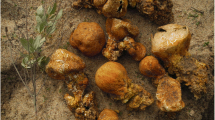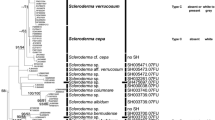Summary
For examination and recognition of mycorrhizal types, the structure of the hyphal mantle in tangential longitudinal sections has proved to be a valuable feature for investigation. Features of hyphal mantle structure have been used for establishing an identification key. The colour of the hyphal mantle is a helpful additional characteristic, but is not useful as a diagnostic feature because of variations in advanced age and under varying environmental conditions. Rhizomorphs yield good taxonomic characteristics. The Hartig net was uniform for all types examined. When differences were observed they had to be interpreted as different stages of development. Ultrastructural examination revealed further features of mycorrhizal types: namely the shape of septal pores, presence and structure of matrix material in the region of the hyphal mantle and characteristic deposits on cell walls of the hyphae. The ten types presented can be distinguished without any ultrastructural features. As far as the fungal partners involved are concerned, basidiomycetes are clearly dominant. For the first time two basidiomycetes with continuous parenthesomes of their dolipores were found to form ectomycorrhizae. Classification of these fungi with the heterobasidiomycetes is discussed.
Similar content being viewed by others
References
Agerer R (1986) Studies on ectomycorrhizae. II Introducing remarks on characterization and identification. Mycotaxon 26: 473–492
Blasius D, Feil W, Kottke I, Oberwinkler F (1986) Hartig net structure and formation in fully ensheathed ectomycorrhizas. Nord J Bot 6: 837–842
Bowen GD, Theodorou C (1967) Studies on phosphate uptake by mycorrhizas. 14th Proc Int Union For Res Organ, vol. 5, p 116
Chilvers GA (1968a) Some distinctive types of eucalypt mycorrhizas. Aust J Bot 16: 49–70
Chilvers GA (1968b) Low-power electron microscopy of the root cap region of Eucalypt mycorrhizas. New Phytol 67: 663–665
Chu-Chou M, Grace LJ (1985) Comparative efficiency of the mycorrhizal fungi Laccaria laccata, Hebeloma crustuliniforme and Rhizopogon species on growth of radiata pine seedlings. N Z J Bot 23: 417–424
Dominik T (1969) Key to ectotrophic mycorrhizae. Folia For Pol Ser A 15: 309–328
Godbout C, Fortin JA (1985) Synthesized ectomycorrhizae of aspen: fungal genus level of structural characterization. Can J Bot 63: 252–262
Gronbach E, Agerer R (1986) Charakterisierung und Inventur der Fichten-Mykorrhizen im Höglwald und deren Reaktionen auf saure Beregnung. Forstwiss Centralbl 105: 329–335
Harley JL, Smith SE (1983) Mycorrhizal symbiosis. Academic Press, London New York
Haug I (1987) Licht- und elektronenmikroskopische Untersuchungen an Mykorrhizen von Fichtenbeständen im Schwarzwald. Dissertation Tübingen
Haug I, Kottke I, Oberwinkler F (1986) Licht- und elektronenmikroskopische Untersuchungen von Mykorrhizen der Fichte (Picea abies (L.) Karst.) in Vertikalprofilen. Z Mykol 52: 373–391
von Hofsten A (1969) The ultrastructure of mycorrhiza I. Ectotrophic and ectendotrophic mycorrhiza of Pinus silvestris. Sv Bot Tidskr 63: 455–463
Khan SR, Kimbrough JW (1982) A reevaluation of the basidiomycetes based upon septal and basidial structures. Mycotaxon 15: 103–120
Marks GC (1965) The classification and distribution of the mycorrhizas of Pinus radiata. Aust For 29: 238–251
Marks GC, Foster RC (1973) Structure, morphogenesis and ultrastructure of ectomycorrhizae. In: Marks GC, Kozlowski TT (eds) Ectomycorrhizae. Academic Press, London New York, pp 2–35
Oberwinkler F (1985) Anmerkungen zur Evolution und Systematik der Basidiomyceten. Bot Jahrb Syst Pflanzengeschichte Pflanzengeogr 107: 541–580
Perrin R, Garbaye J (1983) Influence of ectomycorrhizae on infectivity of Phytium-infested soils and substrates. Plant Soil 71: 345–351
Richard C, Fortin JA, Fortin A (1971) Protective effect of an ectomycorrhizal fungus against the root pathogen Mycelium radicis atrovirens. Can J For Res 1: 246–251
Scannerini S (1968) Sull' ultrastruttura delle ectomicorrize. II. Ultrastruttura di una micorriza di Ascomicete: Tuber albidum x Pinus strobus. Allionia 14: 77–95
Sinclair WA, Cowles DP, Hee SM (1975) Fusarium root rot of Douglas-fir seedlings: suppression by soil fumigation, fertility management, and inoculation with spores of the fungal symbiont Laccaria laccata. For Sci 21: 390–399
Spurr A (1969) A low-viscosity Epoxy resin embedding medium for electron microscopy. J Ultrastruc Res 26: 31–43
Trappe JM (1962) Fungus associates of ectotrophic mycorrhizae. Bot Rev 28: 538–560
Trappe JM (1967) Principles of classifying ectotrophic mycorrhizae for identification of fungal symbionts. 14th, Proc Int Union For Res Organ Sect 24, pp 46–59
Zak B (1973) Classification of ectomycorrhizae. In: Marks GC, Kozlowski TT (eds) Ectomycorrhizae. Academic Press, London New York, pp 43–74
Author information
Authors and Affiliations
Rights and permissions
About this article
Cite this article
Haug, I., Oberwinkler, F. Some distinctive types of spruce mycorrhizae. Trees 1, 172–188 (1987). https://doi.org/10.1007/BF00193560
Received:
Issue Date:
DOI: https://doi.org/10.1007/BF00193560




